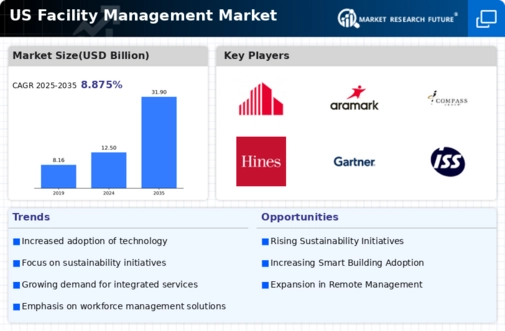Focus on Cost Efficiency
Cost efficiency remains a central concern for organizations within the US facility management market. As businesses seek to optimize their operational budgets, facility management services that offer cost-effective solutions are in high demand. The market has seen a shift towards outsourcing facility management functions to reduce overhead costs. According to industry reports, organizations that outsource facility management can save up to 30% on operational expenses. This trend indicates that facility management providers must demonstrate their value proposition by delivering services that not only meet quality standards but also contribute to significant cost savings. The emphasis on cost efficiency is likely to drive innovation and competition within the industry.
Regulatory Compliance and Standards
The US facility management market is increasingly influenced by regulatory compliance and standards. Various federal and state regulations mandate specific operational practices, particularly in safety, environmental sustainability, and energy efficiency. For instance, the Energy Policy Act and the Clean Air Act impose stringent requirements on facility operations. Compliance with these regulations not only ensures legal adherence but also enhances operational efficiency. As organizations strive to meet these standards, the demand for facility management services that can navigate complex regulatory landscapes is likely to grow. This trend suggests that facility management firms must invest in training and resources to stay updated on evolving regulations, thereby positioning themselves as essential partners in compliance.
Emphasis on Sustainability Practices
Sustainability practices are becoming increasingly vital in the US facility management market. Organizations are recognizing the importance of reducing their environmental footprint and are seeking facility management services that align with these goals. The implementation of green building certifications, such as LEED, is on the rise, with over 90,000 projects certified in the US as of 2025. This trend indicates a growing demand for facility management firms that can provide sustainable solutions, such as energy-efficient systems and waste reduction strategies. As sustainability becomes a core business strategy, facility management providers must adapt their offerings to meet the expectations of environmentally conscious clients, thereby enhancing their market position.
Workplace Safety and Health Regulations
Workplace safety and health regulations are a critical driver in the US facility management market. The Occupational Safety and Health Administration (OSHA) sets forth guidelines that organizations must follow to ensure a safe working environment. Compliance with these regulations is not only a legal requirement but also a key factor in employee satisfaction and productivity. As organizations prioritize the health and safety of their workforce, the demand for facility management services that specialize in safety compliance is likely to increase. This trend suggests that facility management firms must stay abreast of OSHA regulations and implement best practices to ensure workplace safety, thereby enhancing their value to clients.
Technological Advancements in Facility Management
The integration of advanced technologies is a pivotal driver in the US facility management market. Innovations such as Internet of Things (IoT) devices, artificial intelligence, and building management systems are transforming how facilities are managed. For example, IoT sensors can monitor energy usage in real-time, leading to more efficient resource allocation. According to recent data, the adoption of smart building technologies is projected to increase by over 20% annually through 2026. This technological shift not only enhances operational efficiency but also improves occupant experience, making it a critical factor for organizations looking to optimize their facilities. As technology continues to evolve, facility management firms must adapt to leverage these advancements effectively.


























































